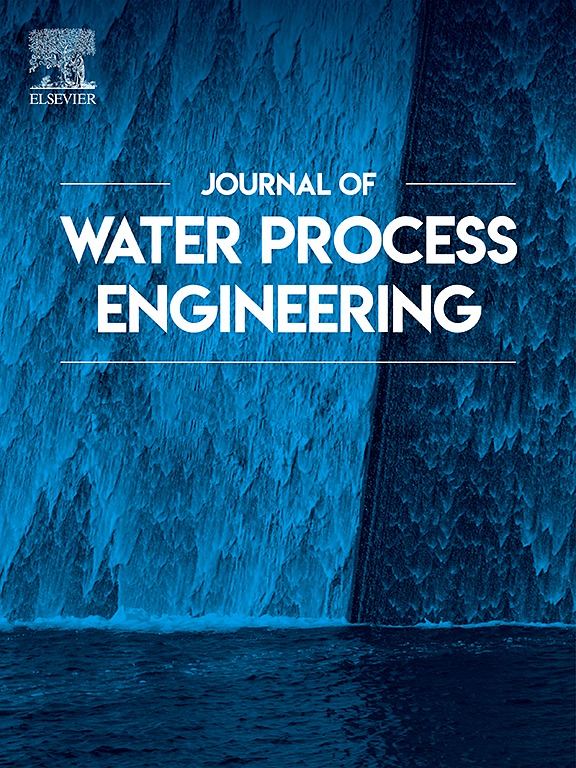Rapid green degradation of ethylene glycol-based antifreeze wastewater via a coupled photolytic and photocatalytic double-pathway mechanism
IF 6.3
2区 工程技术
Q1 ENGINEERING, CHEMICAL
引用次数: 0
Abstract
Ethylene glycol (EG)-based antifreeze wastewater, commonly found in industrial and daily applications, is difficult to treat using low-cost and efficient methods. This study introduces a novel ultraviolet (UV)/P25/O₂ photodegradation process for EG-containing wastewater, powered by sunlight. A key finding of this research is the self-generation of hydrogen peroxide (H₂O₂) through the homolysis of EG's C![]() O and C
O and C![]() H bonds under UV light, which plays a critical role in the degradation process. The P25 photocatalyst effectively accelerates the decomposition of H₂O₂ into hydroxyl radicals (·OH), facilitating the degradation of EG. The dual-pathway mechanism, combining photolysis and photocatalysis, leads to the complete mineralization of a 530 mg·L−1 EG solution within 1.4 h under UV light, achieving a COD removal efficiency of 98.30 %. Furthermore, after five cycles, the degradation efficiency only decreased by 11.66 %, demonstrating strong cycling stability. Experiments show that the process can effectively degrade real antifreeze wastewater collected from the airport under natural sunlight and in the presence of air. This research highlights the high applicability of the UV/P25/O₂ system as a simple, green, and cost-effective solution for on-site EG wastewater treatment under natural sunlight.
H bonds under UV light, which plays a critical role in the degradation process. The P25 photocatalyst effectively accelerates the decomposition of H₂O₂ into hydroxyl radicals (·OH), facilitating the degradation of EG. The dual-pathway mechanism, combining photolysis and photocatalysis, leads to the complete mineralization of a 530 mg·L−1 EG solution within 1.4 h under UV light, achieving a COD removal efficiency of 98.30 %. Furthermore, after five cycles, the degradation efficiency only decreased by 11.66 %, demonstrating strong cycling stability. Experiments show that the process can effectively degrade real antifreeze wastewater collected from the airport under natural sunlight and in the presence of air. This research highlights the high applicability of the UV/P25/O₂ system as a simple, green, and cost-effective solution for on-site EG wastewater treatment under natural sunlight.
求助全文
约1分钟内获得全文
求助全文
来源期刊

Journal of water process engineering
Biochemistry, Genetics and Molecular Biology-Biotechnology
CiteScore
10.70
自引率
8.60%
发文量
846
审稿时长
24 days
期刊介绍:
The Journal of Water Process Engineering aims to publish refereed, high-quality research papers with significant novelty and impact in all areas of the engineering of water and wastewater processing . Papers on advanced and novel treatment processes and technologies are particularly welcome. The Journal considers papers in areas such as nanotechnology and biotechnology applications in water, novel oxidation and separation processes, membrane processes (except those for desalination) , catalytic processes for the removal of water contaminants, sustainable processes, water reuse and recycling, water use and wastewater minimization, integrated/hybrid technology, process modeling of water treatment and novel treatment processes. Submissions on the subject of adsorbents, including standard measurements of adsorption kinetics and equilibrium will only be considered if there is a genuine case for novelty and contribution, for example highly novel, sustainable adsorbents and their use: papers on activated carbon-type materials derived from natural matter, or surfactant-modified clays and related minerals, would not fulfil this criterion. The Journal particularly welcomes contributions involving environmentally, economically and socially sustainable technology for water treatment, including those which are energy-efficient, with minimal or no chemical consumption, and capable of water recycling and reuse that minimizes the direct disposal of wastewater to the aquatic environment. Papers that describe novel ideas for solving issues related to water quality and availability are also welcome, as are those that show the transfer of techniques from other disciplines. The Journal will consider papers dealing with processes for various water matrices including drinking water (except desalination), domestic, urban and industrial wastewaters, in addition to their residues. It is expected that the journal will be of particular relevance to chemical and process engineers working in the field. The Journal welcomes Full Text papers, Short Communications, State-of-the-Art Reviews and Letters to Editors and Case Studies
 求助内容:
求助内容: 应助结果提醒方式:
应助结果提醒方式:


